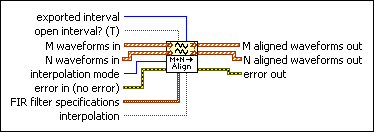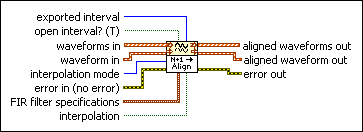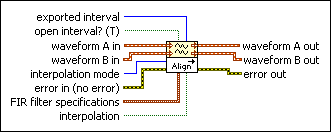 |
exported interval defines the time stamp of the waveform outputs.
|
 |
open interval? defines the interval over which the input waveform extends. The default is TRUE, which selects an open interval. For example, assume an input waveform contains 3 data elements at t = {0, dt, 2dt}. An open interval defines the waveform as extending over the time interval 0  t < 2dt, and a closed interval defines the waveform as extending over the time interval 0 t < 2dt, and a closed interval defines the waveform as extending over the time interval 0  t < 3dt. t < 3dt.
|
 |
waveforms in is an array of waveforms to align.
|
 |
interpolation mode specifies the interpolation method.
| 0 | Coerce—Each output sample is set equal to the input sample value that is closest to it in time. | | 1 | Linear (default)—Each output sample value is a linear interpolation between the two input samples that are closest to it in time. | | 2 | Spline—Uses the spline interpolation algorithm to compute the resampled values. | | 3 | FIR filter—Uses a finite impulse response (FIR) filtering algorithm to compute the resampled values. |
|
 |
error in describes error conditions that occur before this node runs. This input provides standard error in functionality.
|
 |
FIR filter specifications specifies the minimum values this VI needs to specify the FIR filter.
 |
alias rejection (dB) specifies the minimum attenuation level of signal components aliased after any resampling operation. The default is 120.
|
 |
normalized bandwidth specifies the fraction of the new sampling rate that is not attenuated. The default is 0.4536.
|
|
 |
interpolation specifies whether interpolation is performed. The default is TRUE.
|
 |
aligned waveforms out is an array of aligned waveforms.
|
 |
error out contains error information. This output provides standard error out functionality.
|
 |
exported interval defines the time stamp of the waveform outputs.
|
 |
open interval? defines the interval over which the input waveform extends. The default is TRUE, which selects an open interval. For example, assume an input waveform contains 3 data elements at t = {0, dt, 2dt}. An open interval defines the waveform as extending over the time interval 0  t < 2dt, and a closed interval defines the waveform as extending over the time interval 0 t < 2dt, and a closed interval defines the waveform as extending over the time interval 0  t < 3dt. t < 3dt.
|
 |
M waveforms in is an array of waveforms to align.
|
 |
N waveforms in is an array of waveforms to align.
|
 |
interpolation mode specifies the interpolation method.
| 0 | Coerce—Each output sample is set equal to the input sample value that is closest to it in time. | | 1 | Linear (default)—Each output sample value is a linear interpolation between the two input samples that are closest to it in time. | | 2 | Spline—Uses the spline interpolation algorithm to compute the resampled values. | | 3 | FIR filter—Uses a finite impulse response (FIR) filtering algorithm to compute the resampled values. |
|
 |
error in describes error conditions that occur before this node runs. This input provides standard error in functionality.
|
 |
FIR filter specifications specifies the minimum values this VI needs to specify the FIR filter.
 |
alias rejection (dB) specifies the minimum attenuation level of signal components aliased after any resampling operation. The default is 120.
|
 |
normalized bandwidth specifies the fraction of the new sampling rate that is not attenuated. The default is 0.4536.
|
|
 |
interpolation specifies whether interpolation is performed. The default is TRUE.
|
 |
M aligned waveforms out is an array of aligned waveforms.
|
 |
N aligned waveforms out is an array of aligned waveforms.
|
 |
error out contains error information. This output provides standard error out functionality.
|
 |
exported interval defines the time stamp of the waveform outputs.
|
 |
open interval? defines the interval over which the input waveform extends. The default is TRUE, which selects an open interval. For example, assume an input waveform contains 3 data elements at t = {0, dt, 2dt}. An open interval defines the waveform as extending over the time interval 0  t < 2dt, and a closed interval defines the waveform as extending over the time interval 0 t < 2dt, and a closed interval defines the waveform as extending over the time interval 0  t < 3dt. t < 3dt.
|
 |
waveforms in is an array of waveforms to align.
|
 |
waveform in is a waveform to align.
|
 |
interpolation mode specifies the interpolation method.
| 0 | Coerce—Each output sample is set equal to the input sample value that is closest to it in time. | | 1 | Linear (default)—Each output sample value is a linear interpolation between the two input samples that are closest to it in time. | | 2 | Spline—Uses the spline interpolation algorithm to compute the resampled values. | | 3 | FIR filter—Uses a finite impulse response (FIR) filtering algorithm to compute the resampled values. |
|
 |
error in describes error conditions that occur before this node runs. This input provides standard error in functionality.
|
 |
FIR filter specifications specifies the minimum values this VI needs to specify the FIR filter.
 |
alias rejection (dB) specifies the minimum attenuation level of signal components aliased after any resampling operation. The default is 120.
|
 |
normalized bandwidth specifies the fraction of the new sampling rate that is not attenuated. The default is 0.4536.
|
|
 |
interpolation specifies whether interpolation is performed. The default is TRUE.
|
 |
aligned waveforms out is an array of aligned waveforms.
|
 |
aligned waveform out contains an aligned waveform.
|
 |
error out contains error information. This output provides standard error out functionality.
|
 |
exported interval defines the time stamp of the waveform outputs.
|
 |
open interval? defines the interval over which the input waveform extends. The default is TRUE, which selects an open interval. For example, assume an input waveform contains 3 data elements at t = {0, dt, 2dt}. An open interval defines the waveform as extending over the time interval 0  t < 2dt, and a closed interval defines the waveform as extending over the time interval 0 t < 2dt, and a closed interval defines the waveform as extending over the time interval 0  t < 3dt. t < 3dt.
|
 |
waveforms in is an array of waveforms to align.
|
 |
waveform in is a waveform to align.
|
 |
interpolation mode specifies the interpolation method.
| 0 | Coerce—Each output sample is set equal to the input sample value that is closest to it in time. | | 1 | Linear (default)—Each output sample value is a linear interpolation between the two input samples that are closest to it in time. | | 2 | Spline—Uses the spline interpolation algorithm to compute the resampled values. | | 3 | FIR filter—Uses a finite impulse response (FIR) filtering algorithm to compute the resampled values. |
|
 |
error in describes error conditions that occur before this node runs. This input provides standard error in functionality.
|
 |
FIR filter specifications specifies the minimum values this VI needs to specify the FIR filter.
 |
alias rejection (dB) specifies the minimum attenuation level of signal components aliased after any resampling operation. The default is 120.
|
 |
normalized bandwidth specifies the fraction of the new sampling rate that is not attenuated. The default is 0.4536.
|
|
 |
interpolation specifies whether interpolation is performed. The default is TRUE.
|
 |
aligned waveforms out is an array of aligned waveforms.
|
 |
aligned waveform out contains an aligned waveform.
|
 |
error out contains error information. This output provides standard error out functionality.
|
 |
exported interval defines the time stamp of the waveform outputs.
|
 |
open interval? defines the interval over which the input waveform extends. The default is TRUE, which selects an open interval. For example, assume an input waveform contains 3 data elements at t = {0, dt, 2dt}. An open interval defines the waveform as extending over the time interval 0  t < 2dt, and a closed interval defines the waveform as extending over the time interval 0 t < 2dt, and a closed interval defines the waveform as extending over the time interval 0  t < 3dt. t < 3dt.
|
 |
waveform A in is a waveform to align.
|
 |
waveform A out is the waveform that results from aligning waveform A in and waveform B in.
|
 |
interpolation mode specifies the interpolation method.
| 0 | Coerce—Each output sample is set equal to the input sample value that is closest to it in time. | | 1 | Linear (default)—Each output sample value is a linear interpolation between the two input samples that are closest to it in time. | | 2 | Spline—Uses the spline interpolation algorithm to compute the resampled values. | | 3 | FIR filter—Uses a finite impulse response (FIR) filtering algorithm to compute the resampled values. |
|
 |
error in describes error conditions that occur before this node runs. This input provides standard error in functionality.
|
 |
FIR filter specifications specifies the minimum values this VI needs to specify the FIR filter.
 |
alias rejection (dB) specifies the minimum attenuation level of signal components aliased after any resampling operation. The default is 120.
|
 |
normalized bandwidth specifies the fraction of the new sampling rate that is not attenuated. The default is 0.4536.
|
|
 |
interpolation specifies whether interpolation is performed. The default is TRUE.
|
 |
waveform B in is a waveform to align.
|
 |
waveform B out is the waveform that results from aligning waveform B in and waveform A in.
|
 |
error out contains error information. This output provides standard error out functionality.
|
 Add to the block diagram
Add to the block diagram Find on the palette
Find on the palette


 t < 2dt, and a closed interval defines the waveform as extending over the time interval 0
t < 2dt, and a closed interval defines the waveform as extending over the time interval 0 










